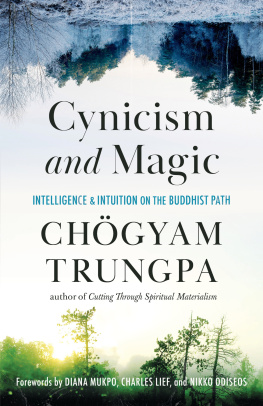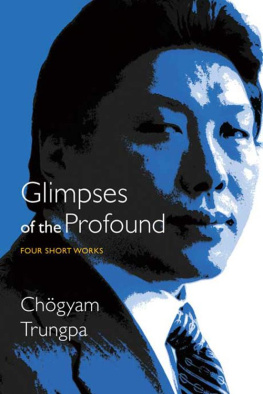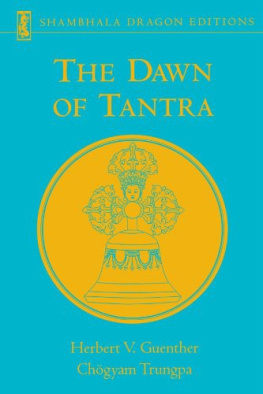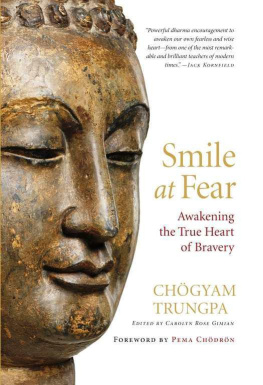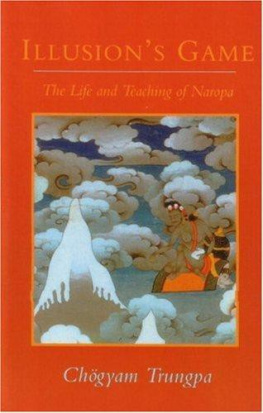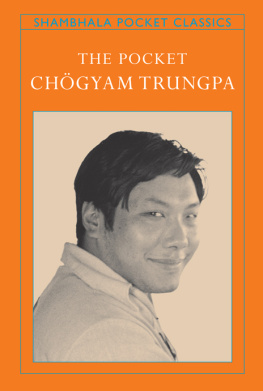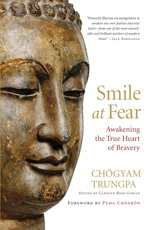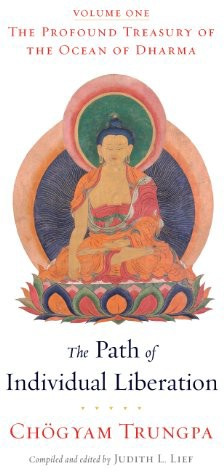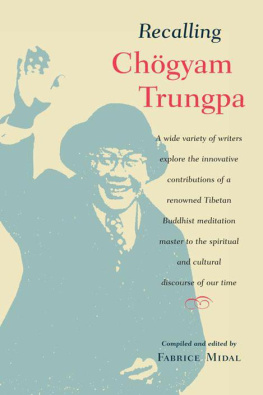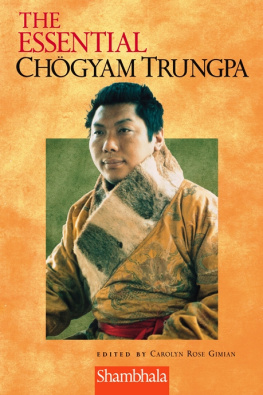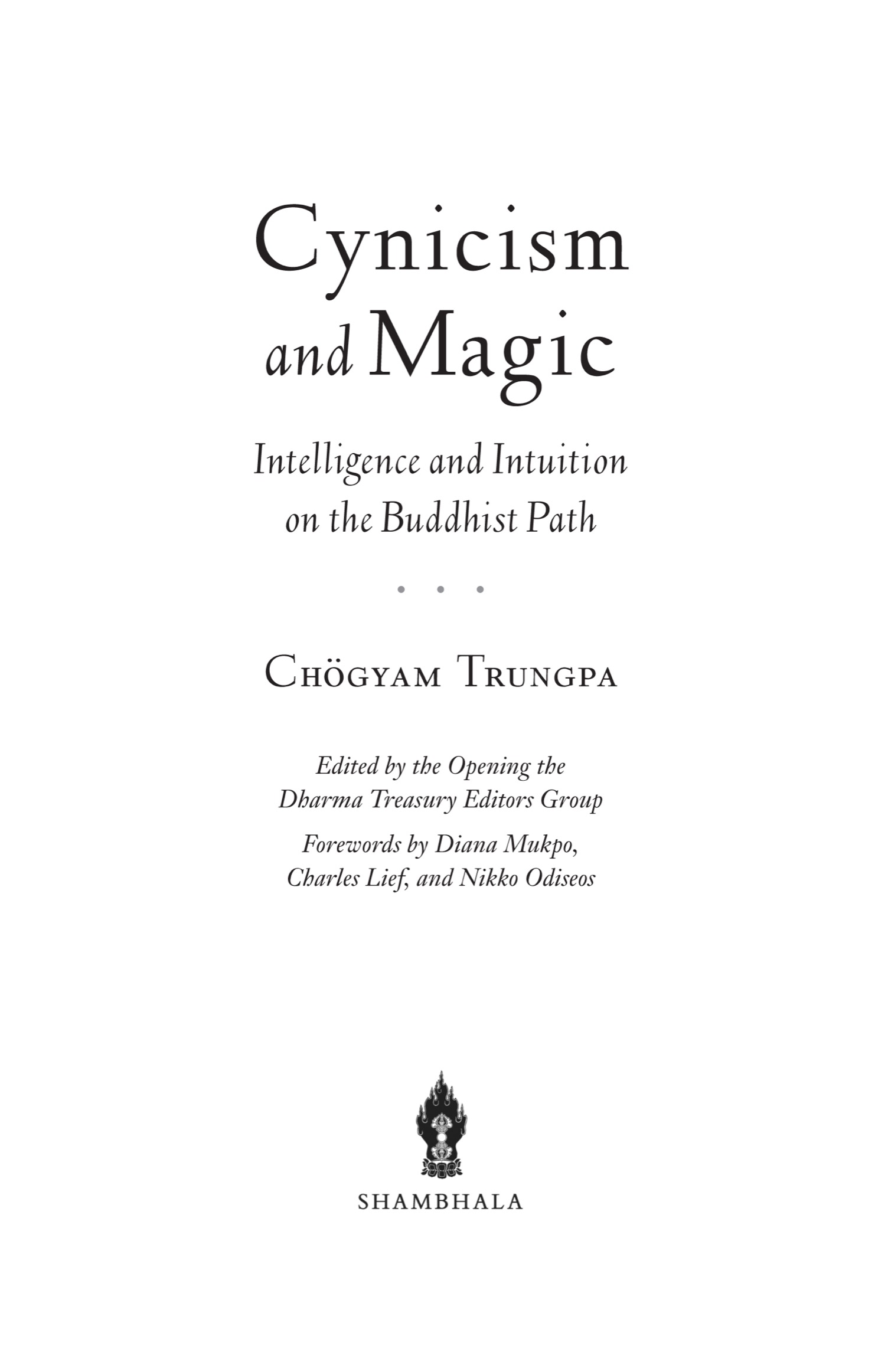Contents
Landmarks
Print Page List
Shambhala Publications, Inc.
2129 13th Street
Boulder, CO 80302
www.shambhala.com
2021 by Diana J. Mukpo
Frontispiece: Chgyam Trungpa teaching at Naropa, 1974.
Photo by Hudson Shotwell.
Cover photos: Liam Grant/Stocksy
and Abbie Velker/iStock
Cover design: Daniel Urban-Brown
Interior design: Steve Dyer
All rights reserved. No part of this book may be reproduced in any form or by any means, electronic or mechanical, including photocopying, recording, or by any information storage and retrieval system, without permission in writing from the publisher.
LIBRARY OF CONGRESS CATALOGING - IN - PUBLICATION DATA
Names: Trungpa, Chgyam, 19391987, author.
Title: Cynicism and magic:
Intelligence and intuition on the Buddhist path / Chgyam Trungpa.
Description: Boulder: Shambhala, 2021. |
Includes bibliographical references and index.
Identifiers: LCCN 2020035280 | ISBN 9781611808094 (paperback) eISBN 9780834843585
Subjects: LCSH : BuddhismEssence, genius, nature. |
Buddhist geography. | Buddhist modernism. |
Religious lifeBuddhism. | Spiritual LifeBuddhism.
Classification: LCC BQ 4036 . T 74 2021 | DDC 294.3/444dc23
LC record available at https://lccn.loc.gov/2020035280
a_prh_5.7.0_c0_r0
CONTENTS
FOREWORD BY DIANA MUKPO
I VE BEEN FOLLOWING the training of a new group of editors, who are called the Opening the Dharma Treasury Editors Group. For the past four years, they have been learning to accurately transcribe and edit, and thus transmit, the dharma teachings of my late husband, Chgyam Trungpa Rinpoche. It is so impressive that this group of young editors has now completed their first book together. They have been working under the supervision of two of Rinpoches senior editors, Judith Lief and Carolyn Gimian, who should be commended for their tutelage. I find it personally inspiring to see this work going forward. Everyone associated with this effort should be proud of this accomplishment.
In general, these new editors did not know Trungpa Rinpoche personally, although a few of them met him when they were infants or young children. However, they have really come to know him through his words. They have been inspired by his teachings, and now they are passing along that inspiration to all of us, through this thoroughly delightful and powerful new book.
This is a wonderful model for the cross-generational transmission of Buddhist teachings, new students learning from the old, showing how Buddhism remains culturally applicable, and demonstrating that tradition and modernity can find a meeting point.
Im sure that Trungpa Rinpoche would be especially touched and delighted to see this project going forward and to know that his teachings are now being edited and shared by a new generation. It is my aspiration that all of the teachings of Chgyam Trungpa Rinpoche will be made available by his editors, new and old. There is much work that remains to be done, but this first effort of the ODT editors is an excellent one. It is putting down a good markerand now these talented new editors will find that they have much more work to do!
This book is a fresh and genuine approach to Rinpoches teachings. I hope it is just the first of many to come.
With appreciation and joy,
D IANA J UDITH M UKPO
Providence, 2020
Rinpoche, which translates to precious one, is a title often given to Tibetan lamas.
FOREWORD BY CHARLES LIEF
I AM PROUD OF THE ROLE Naropa has played in hosting the training programs in which the editors of this wonderful book could learn their craft. Its auspicious that the first book is based on the inaugural class that Naropas founder, Chgyam Trungpa, offered at our inaugural summer in 1974. Those teachings planted a seed that flourished in Naropas evolution as a university.
In 1974, Boulder became the epicenter of a Buddhist revolution. An emergent form of Buddhism, anchored to a Western cultural foundation, arose. Trungpa Rinpoche was unique among peers in teaching in English, rather than in Tibetan with translation. That decision both made the dharma more accessible to Western students and allowed him to evolve an English idiomatic vocabulary capturing the nuances, immediacy, and depth of the teachings. Naropa offers bachelors and masters degrees in a variety of disciplines, but it remains unique in its role as the first university in North America where contemplative and compassion practices are interwoven in the curriculum.
Trungpa Rinpoche took chances, not the least of which was placing unflagging trust in his Western students. He encouraged a few students to take on the daunting task of editing his thousands of talks, classes, and poems. To date, more than fifty volumes have been published in thirty languages, well edited and brilliantly organized. My wife, Judy, has been doing this work for forty-five years, so I have long seen the way in which an editors entire being must be invested in the subject in order for a genuine and transformative product to emerge.
To transmit the skill and practice of editing dharma teachings to a new generation of editors, Naropa launched the Opening the Dharma Treasury (ODT) initiative in 2016, led by Trungpa Rinpoches principal editors Carolyn Gimian and Judy Lief. Now in its fifth year, the ODT has been generously supported by Shambhala Publications and the Hemera Foundation. Judy and Carolyn are owed much gratitude for modeling Trungpa Rinpoches full commitment to teaching, mentoring, and trusting younger students. That mentorship is based on their heartfelt commitment to help a new generation of editors continue this literary lineage. Beyond training editors to work on the more than one thousand still unedited and unpublished teachings by Trungpa Rinpoche, the newer editors and writers are preparing to contribute to the offerings of other Buddhist teachers as well. ODT is facilitating a generational shift and ensuring readers will have well-produced dharma teaching for decades to come.
ODT is housed within the Chgyam Trungpa Institute at Naropaa center to study Trungpa Rinpoches influence on society and the arts and to explore the complex, challenging, and at times controversial history and impact of the arrival of Buddhism in the West, as well as the teachers who brought it here.
It is fitting that Shambhala Publications is bringing out the first significant work of this new editorial group, fitting also that it be Cynicism and Magic, drawn from the first talks offered by Trungpa Rinpoche at the opening summer of Naropa Institute. Reading the manuscript was a powerful reminder of how remarkable these first teachings were. They quickly established that to study and practice true Buddhism one need not be religious. As Trungpa Rinpoche said, Thats the starting point, the basic attitude of practicing meditation: boycotting ego. Not as the villain or enemy, but we dont give it any more fuel. We let ego have an energy crisis. That could be considered the premise of the countless programs teaching secular mindfulness, drawn from Buddhism but not Buddhist per se. As the reader will find while exploring these pages, the foundation of secular mindfulness, and of compassion teachings and practice, arose from Trungpa Rinpoches pioneering efforts. And that was very much his intention, and indeed is itself very Buddhist.

